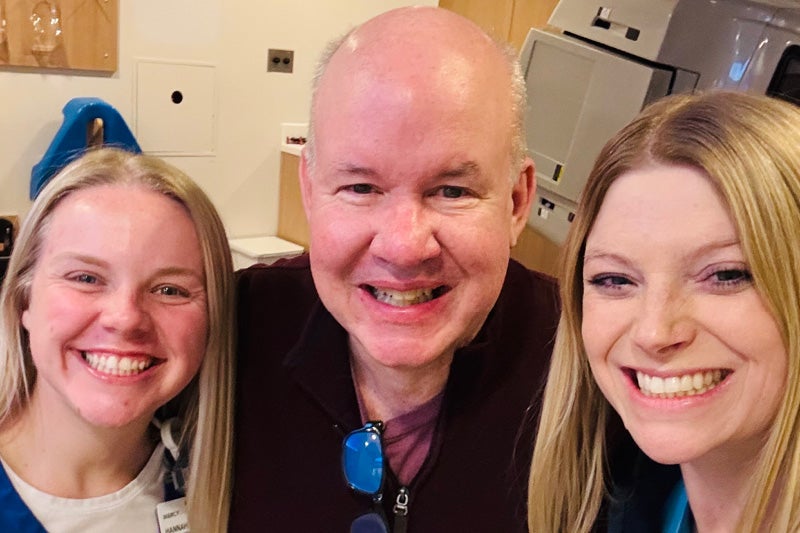
Learn more about MercyOne Cancer Care
Doug Sawyer felt vulnerable as he waited for his first of 15 radiation treatments for cancer. The giant machine. The radiation beam aimed at his head. The uncertainty of how his body would respond.
It seemed so daunting until he experienced the kindness and compassion from the radiation therapists at MercyOne Des Moines Radiation Oncology. They eased his fears and set a positive tone for his next 14 radiation treatments.
“Guys don’t always show their emotions, but I’ll admit I felt very nervous going into radiation vault 2 and having a radiation beam pointed at my skull,” said Doug of Urbandale, Iowa. “However, it’s the kindness of the radiation therapists I’ll remember most. Connections with people are so important and so appreciated when you’re filled with trepidation.”
One radiation therapist, Alyssa, made a lasting impression when she told him. “I’m never going to forget your name because my dad’s name is Doug and my son’s name is Sawyer.”
“Obviously to me it was very comforting that she shared that,” Doug recalled. “Another radiation therapist was named Hannah, the name of my oldest daughter, a nurse. Sharing their personal connections was so thoughtful and helped me feel like everything was going to be OK.”
Red spot signals cancer
It started with a red patch on the top of his head that prompted him to see a dermatologist. The spot tested negative for skin cancer, but the doctor told him he needed to see an oncologist.
Doug was later diagnosed with non-Hodgkin's lymphoma. “It’s very difficult when you get the diagnosis because at that point, there’s so much you don’t know.”
Non-Hodgkins lymphoma is a type of cancer that starts in the lymphatic system. Germ-fighting cells in the lymphatic system grow out of control, and the cells can form growths, or tumors, throughout the body. The best way to find lymphoma early is to pay attention to possible signs and symptoms.
Among the most common cancers, the chance that a man will develop non-Hodgkin's lymphoma is about 1 in 44; for a woman, the risk is about 1 in 54, according to the American Cancer Society.
Oncologist Bradley Hiatt, DO, ordered a PET scan to see if the cancer had spread through Doug’s lymphatic system. “From the results, it was clear it was only in this one spot I had on top of my skull and that was very encouraging news,” Doug said.
It was recommended Doug undergo 15 consecutive radiation treatments over three weeks.
White glove treatment
“I was very fortunate in that I tolerated the treatments,” Doug said. “I didn’t miss any work. I continued to coach youth soccer, and I didn’t miss any games or practices. I led a very active life during the month (April 2025) of my treatments. I was out on the soccer field three nights a week and every weekend.”
The luck of the cancer visibly showing up as a red patch atop his bald head is not lost on Doug. “It showed up on a very easy place to spot, and I credit my wife for urging me to go to the dermatologist right away to get it checked out.”
While he knows there are others with cancer who have more serious diagnoses and difficult treatment regimens, he says. “The process isn’t easy for anyone. I really gave my trust to the medical professionals, listened closely, asked questions and followed their guidance.”
Meanwhile, he was impressed by his MercyOne experience. “My cancer care was very organized -- from the ‘rock star’ parking to my treatment within minutes of arrival. I felt like I was on the red carpet and received the white glove treatment wherever I went.”
And most important were those personal connections, too.
